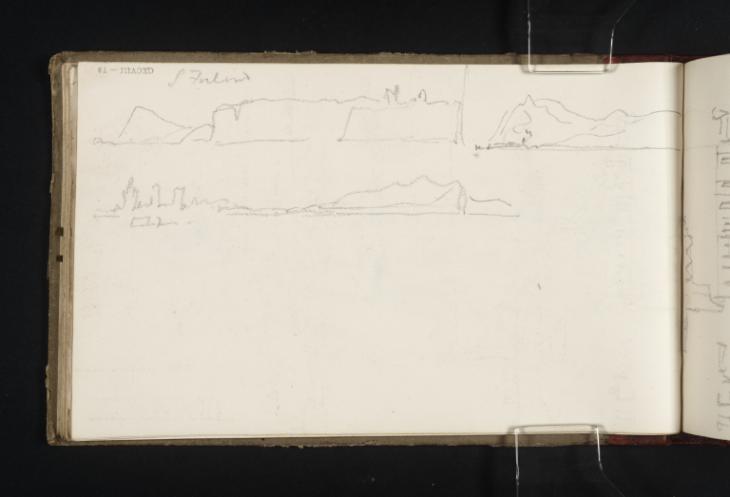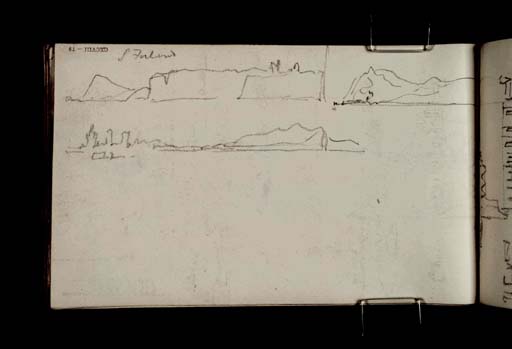Joseph Mallord William Turner Views of Dover and Calais c.1821-2
Image 1 of 2
Joseph Mallord William Turner,
Views of Dover and Calais
c.1821-2
Joseph Mallord William Turner 1775–1851
Folio 79 Recto:
Views of Dover and Calais c.1821–2
D17341
Turner Bequest CXCVIII 79
Turner Bequest CXCVIII 79
Pencil on white wove paper, 113 x 187 mm
Partial watermark ‘T Edm | 18’
Inscribed by Turner in pencil ‘S Foreland’ towards top left
Inscribed by John Ruskin in red ink ‘79’ top left, upside down
Stamped in black ‘CXCVIII – 79’ top left, upside down
Partial watermark ‘T Edm | 18’
Inscribed by Turner in pencil ‘S Foreland’ towards top left
Inscribed by John Ruskin in red ink ‘79’ top left, upside down
Stamped in black ‘CXCVIII – 79’ top left, upside down
Accepted by the nation as part of the Turner Bequest 1856
References
1909
A.J. Finberg, A Complete Inventory of the Drawings of the Turner Bequest, London 1909, vol.I, p.606, CXCVIII 79, as ‘“South Foreland,” &c., from the Channel’.
The three drawings on this page are all records of illustrations in The Little Sea Torch, an illustrated maritime text by Richard Bougard, translated from the French by J.T. Serres and published in London in 1801.1 For more detailed information about the publication, and an interrogation of Turner’s use of it, see the sketchbook Introduction. For a comprehensive list of the other pages in this sketchbook used for the same purpose, see the entry for folio 55 recto (D17296).
Made with the page inverted according to the foliation of the sketchbook, at top left Turner transcribes a view of South Foreland, on the Kent coast near Dover, taken from plate 1 of the printed source.2 The sketch is inscribed ‘S Foreland’ at top left, confirming this identification. The original engraving is titled ‘The South Foreland and Shakespeare Cliff’.3 Turner delineates the distinctive pointed shape of Shakespeare Cliff at far left, as well as the lighthouses at South Foreland standing on the cliff top towards the right. Throughout the present sketchbook Turner records a number of studies of South Foreland, both from life and using other examples in The Little Sea Torch. These instances are listed in the entry for folio 8 recto (D17220).
At top right Turner makes a copy of ‘Entrance of Dover Harbour’, also on the first plate of The Little Sea Torch.4 A close view of Shakespeare Cliff and the harbour architecture is translated by the artist into a summary image comprised of fluid, gestural lines which denote the overall topographical shapes. Dover is a subject that also interests Turner throughout the present sketchbook, and for a list of pages which demonstrate this, see the entries for folio 24 recto and 71 verso (D17247, D17329). For further studies of Shakespeare Cliff, see the entry for folio 38 verso (D17272).
The final drawing on this page, made directly below the first two but still in the upper half of the space available, comes from the seventh illustration on plate 1 of The Little Sea Torch: ‘Calais Town and Cliff’.5 At left Turner describes three elaborate towers delineated in the original image, and the architectural paraphernalia that surrounds them is indicated briefly. Both iterations of the scene depict the flowing, organic forms of the cliffs and mainland.
Maud Whatley
January 2016
Richard Bougard, The Little Sea Torch: or, True Guide for Coasting Pilots: by which they are clearly instructed how to navigate along the coasts of Malta, Corsica, Sardinia, and others in the Straits; and of The Coast of Barbary, from Cape Bon to Cape de Verd, trans. with corrections and additions by John Thomas Serres, London 1801. For an online and PDF facsimile, see ‘The Little Sea Torch’ accessed 26 October 2015, Biblioteca Nacional de Portugal, http://purl.pt/23500 ,.
‘Plate 1’, The Little Sea Torch, accessed 19 November 2015, http://purl.pt/23500/1/index.html#/151/html .
How to cite
Maud Whatley, ‘Views of Dover and Calais c.1821–2 by Joseph Mallord William Turner’, catalogue entry, January 2016, in David Blayney Brown (ed.), J.M.W. Turner: Sketchbooks, Drawings and Watercolours, Tate Research Publication, February 2017, https://www


